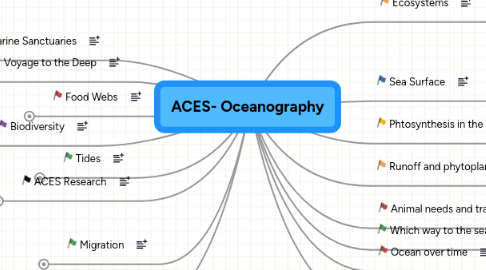ACES- Oceanography
by Kathy Spicer


1. Migration
1.1. Pathways of marine life
1.2. Compare and Contrast movement of different animals.
1.3. Consider how needs are met in the ocean.
2. National Marine Sanctuaries
2.1. Olympic Coast
2.2. Cordell Bank
2.3. Gulf of the Farallones
2.4. Channel Islands
2.5. Hawaiian Island Humpback Whale
2.6. Northwestern Hawaiian Islands
2.7. Fagatele Bay
2.8. Flower Garden Bank
2.9. Florida Keys
2.10. Gray's Reef
2.11. Monitor
2.12. Stellwagen Bank
2.13. Thunder Bay
2.14. Monterey Bay
2.15. National Marine
3. Seasons of Change.
3.1. Solar radiation and Earth's tilt
3.2. Distance of Sun not related to seasons.
3.3. Rays matter
4. Voyage to the Deep
4.1. Pressure and light change.
4.2. Coping mechanisms of animals of the deep.
5. Biodiversity
5.1. Organisms in the sea
5.2. Cells, Fundamental unit of life.
5.3. Adaptations of marine species.
5.4. Similarities and differences between organisms.
6. Food Webs
6.1. Web construction
6.2. Role of phytoplankton
7. Tides
7.1. Connection between tides and how the sun, moon and Earth are aligned.
7.2. Marine reproduction can be related to tides.
8. ACES Research
8.1. Use of website
9. Ecosystems
9.1. Open Ocean
9.2. Deep Sea
9.3. Mangrove Forest
9.4. Kelp Forest
9.5. Coral Reef
9.6. Rocky Shore
9.7. Polar Sea
9.8. Salt Marsh
10. Ocean over time
10.1. Food
10.2. Products from the sea
10.3. Recreation
10.4. Trade and Navigation
10.5. Scientific Exploration and Research
10.6. National Security
10.7. Ecosystem protection and management
10.8. Humans and the ocean
11. Explore the sea floor
11.1. mapping
11.2. graphing
11.3. identifying,locating and describing topography.
11.3.1. Bathymetry
